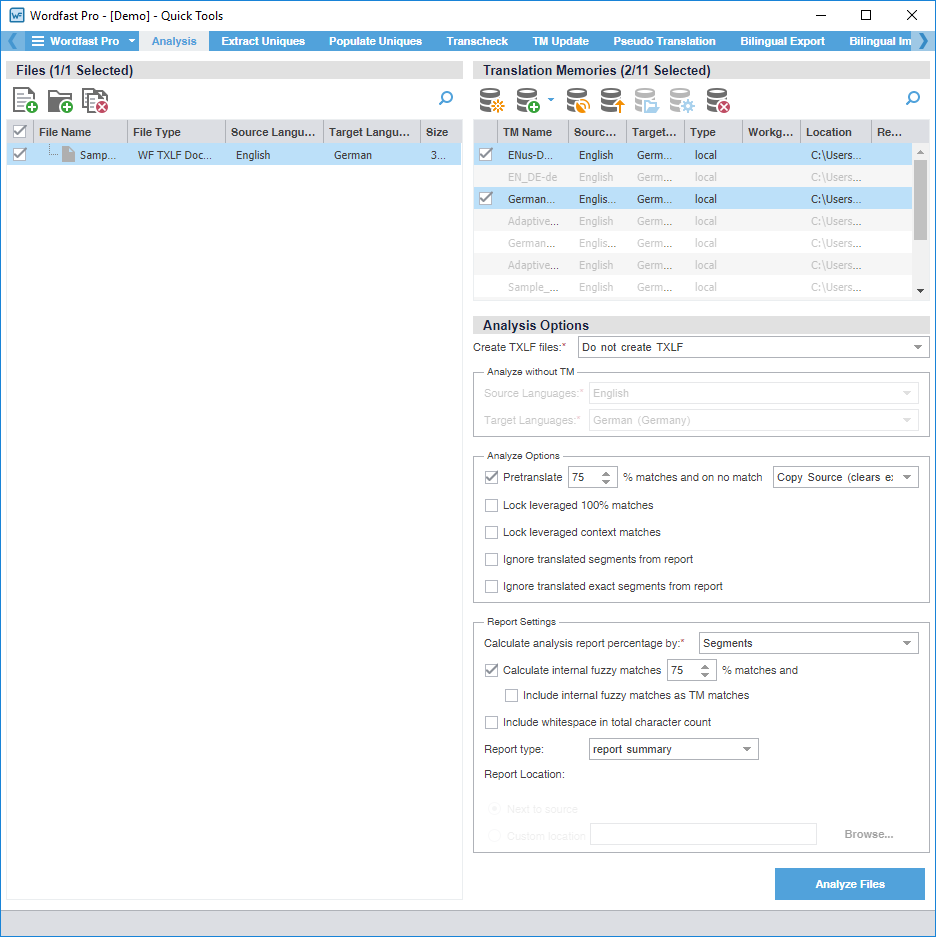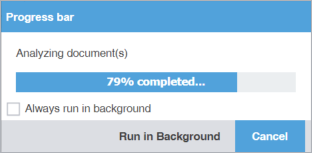You can use actions on the Analysis tab to create TXLF files or assess potential translation memory (TM) matches and repetitions for selected source files.
Analyze without using the TM panel is a quick way to obtain the word count of the files before TM leveraging.
| Note: |
You can pre-translate target segments using your TM and machine translation on No Match. You can also select Maintain existing target (if present) to pre-translate only blank target segments and preserve any existing translations in TXLF target segments with no TM match.
To analyze files:
- Click the Wordfast Pro drop-down menu, then select Quick Tools.
- Click the Analysis tab, if it is not already selected.
- On the Files panel, choose one of the following actions:
- (Optional) On the Translation Memories panel, select one or more TMs from the list of available TMs, then choose one of the following actions:
Item
Action
Click to open the Create TM dialog and create a local TM for quick, local access. Refer to Create a Local TM.
Click, then select a local TM or a project TM from the project list from the drop-down list. Refer to Add a Local TM to a Project and Add Project TMs.
Click to open the Connect to Remote TM dialog and complete the appropriate information to connect to a remote TM for the project. Refer to Connect to a Remote Glossary.
Click to open the Import Translation Memory dialog and complete the appropriate information to import a TM for the project. Refer to Import a Local TM.
Click to open and edit the selected TM. Refer to Open and Edit a Local TM.
Depending on the TM you select, click to open either the Modify a Local TM dialog or the Modify a Remote TM dialog, then complete the appropriate information to rename, write-protect, or change the priority of a TM for the project. Refer to Connect to a Remote Glossary.
Click to remove the selected TM from the project list.
- (Optional) On the Analysis Options panel, select the method for bilingual source file creation from the Create TXLF files drop-down list, such as InDesign or MS Word files.
- For Analyze without TM, select the appropriate languages from the Source Languages and Target Languages drop-down list.
- (Optional) Complete Pretranslation Options.
- Select Pretranslate, then set the baseline match percentage for the TM leverage with the type of match from the drop-down list.
Item
Action
When there is no matching target content, select to insert source content in its place.
When there is no matching target content, select to insert source tags in its place.
Select to leverage machine translation (MT) matches for all segments that do not have a TM match.
If you have TM matches, but do not select the TM before you click Analyze, the MT overwrites all target segments.
When there is existing target content, retain it. Otherwise, insert source content in its place.
Overwrite target content with source content.
- Select any of the following actions:
- Select Pretranslate, then set the baseline match percentage for the TM leverage with the type of match from the drop-down list.
- For the Report Settings, choose from the following actions:
- Click Analyze Files.
- (Optional) On the Progress bar dialog, you can select Always run in background to preserve the background batch action for future analysis actions, then click Run in Background.
- If you chose to run Analyze Files in the background, you can monitor its progress.
- After successful completion, view the report, then close the report browser window.


